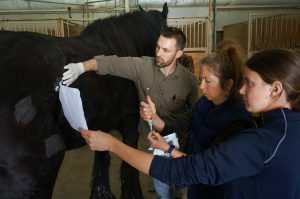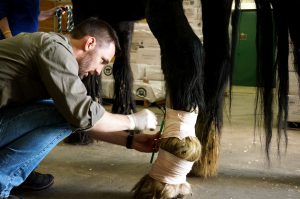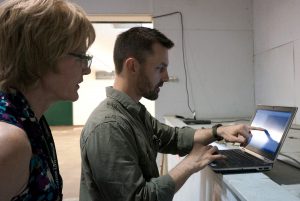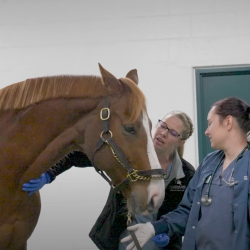Shivers, a concern for performance horses, has no known origin, cure, or treatment. Dr. Stephanie Valberg, MSU Mary Anne McPhail Dressage Chair in Equine Sports Medicine, is working with her team to change that.

Starting the Investigation

In 2015, Dr. Valberg’s team was the first to define specific types of shivers—shivers-hyperflexion, shivers-forward hyperflexion, and shivers-hyperextension. Shivers is a chronic and perplexing neuromuscular disorder in horses. The clinical signs vary in severity and can be observed while the horse is backing up, and only when the horse is walking forward during the advanced stages of the disorder. Shivers is induced by specific movements. In some cases, it produces painful muscle cramps, causing fixed hyperflexion. In other cases, shivers can cause extensor rigidity.
Working with Dr. Anibal Armein, a neuropathologist from the University of Minnesota’s College of Veterinary Medicine, Dr. Valberg’s team determined that shivers might be due to focal cerebellar Purkinje cell axonal degeneration.

Finding a Link
This spring, Dr. Valberg and Dr. Josh Aman, post-doctoral associate in the Department of Neurology at the University of Minnesota, characterized electromyographic (EMG) hind limb muscle activity patterns in horses with shivers and then correlated this with gait abnormalities and cerebellar degeneration.
Drs. Valberg and Aman tested the muscle recruitment pattern of horses with and without shivers during four key movements: when handlers lifted the horse’s hind limbs, and when horses walked backward, walked forward, and trotted. Sensors and electrodes measured activity in individual muscles and transmitted the data through a monitor harness to a computer system.

The data showed that healthy horses did not need to recruit a large proportion of muscle fibers during walking forward and backward, and their flexor and extensor muscles alternated crisply. In shivers horses, a large amount of the muscle mass was recruited, especially during walking backward, and the crisp alternation between the flexor and extensor muscles was disrupted. During backward walking, flexors and extensors fired off massively and simultaneously, causing the trembling that is associated with shivers.
Horses displaying classic shivers gait abnormalities were found to have cerebellar Purkinje cell axonal degeneration. Because the cerebellum regulates the pattern and timing of flexor and extensor muscle recruitment, the results support the thesis that a focal abnormality in the cerebellum causes shivers. This knowledge will help the team focus their research to develop treatments based on the underlying disease process in Purkinje cells. They also plan to develop this EMG technique as a potential diagnostic test for shivers. Right now, there is no diagnostic test beyond clinical observation.

How to Help: Research Participation
The team’s next step is to determine which genes are dysregulated in the cerebellum and whether shivers is inherited. Dr. Valberg’s team is currently looking to obtain DNA from horses with shivers and from Warmblood and Thoroughbred geldings 16.3 h or taller that do not have shivers. Information about submitting a video and hair sample for the team to use in an upcoming genetic study can be found on Dr. Valberg’s website.
Shivers can significantly lower a horse’s quality of life and be a difficult condition for owners to support. When owners of a horse with shivers feel the horse has reached the end of a comfortable life, Dr. Valberg is encouraging owners to consider donating their horse to the shivers study. These donated horses are vital for research to determine a root cause and a treatment or cure. Donated horses will be humanely euthanized and their brains immediately frozen to preserve the cerebellum’s gene expression patterns. The research will focus on the molecular pathways that become dysregulated in the cerebellums of shivers horses.
“When we understand the way cellular function is disrupted in shivers horses, we can target specific pathways for specific and more effective treatment,” said Dr. Valberg.
Owners that wish to donate their horse with shivers may submit a video of their horse walking forward and backward while exhibiting the classic signs of shivers. Once screened and approved by Dr. Valberg’s team, the horse can be donated to MSU. Please email Dr. Valberg for more information.



